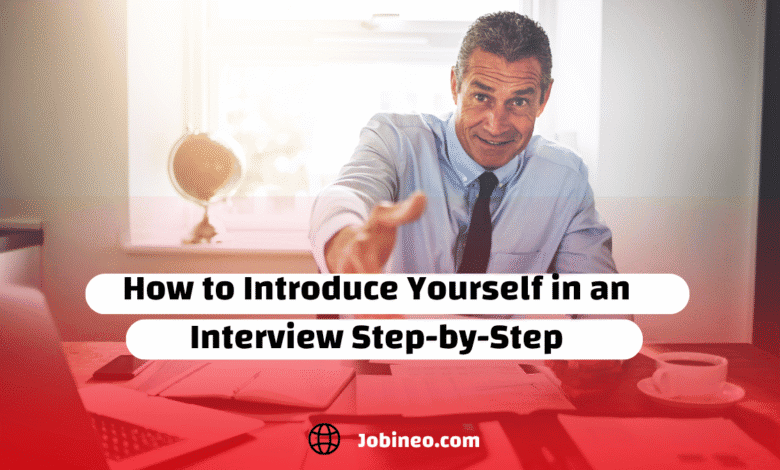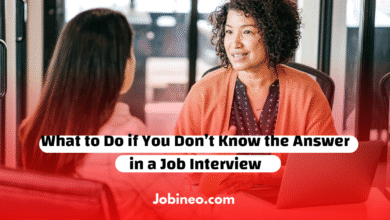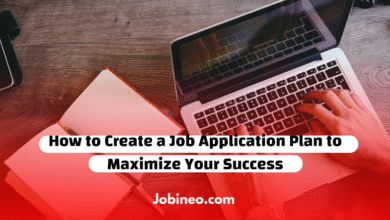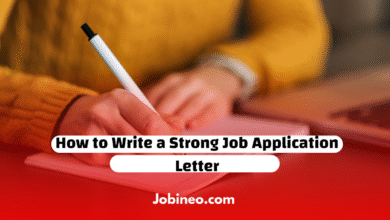How to Introduce Yourself in an Interview Step-by-Step

Your first words in an Interview set the tone for everything that follows. In those crucial opening moments, interviewers form snap judgments about your confidence, professionalism, and fit. A strong introduction builds immediate rapport, while a weak one can derail your chances before you answer a single skill question. Think of it as your “elevator pitch” a concise, compelling snapshot of who you are and why you belong here. Nail this step, and you start your Interview on solid ground.
Table of Contents
How to Introduce Yourself in an Interview: A Step-by-Step Guide
Follow these six steps to create a memorable, authentic Interview introduction:
Step 1: Research the Company and Role
Before crafting your pitch, dig deep into:
- The company’s mission, values, and recent projects.
- The job description’s key responsibilities and “must-have” skills.
- The team culture (check LinkedIn profiles or employee reviews).
Why it works: Tailoring your intro to the company’s needs shows you care and aren’t just reciting a generic script.
Step 2: Craft a Concise Professional Summary
Structure it like this:
- Your current role/field: “I’m a marketing specialist with 5 years in tech…”
- Key expertise: “…focused on social media strategy and brand growth…”
- One relevant achievement: “…who boosted engagement by 40% at Company X.”
Keep it tight: Use active verbs (“managed,” “created,” “achieved”).
Step 3: Align Your Skills with the Job
Explicitly connect your strengths to the role’s requirements. For example:
*”I saw this position requires expertise in project management tools. In my last role, I led teams using Asana to deliver 20+ campaigns on time.”*
Pro Tip: Mention 1–2 skills from the job description using their exact wording.
Step 4: Rehearse (But Don’t Memorize)
Practice aloud until it feels natural not robotic. Focus on:
- Smooth transitions between sentences.
- Natural pauses and tone.
- Adapting if interrupted.
Avoid: Sounding like a recording. Record yourself to catch stiff delivery.
Step 5: Master Body Language
Your words matter, but your presence speaks louder. Remember to:
- Offer a firm handshake (if in-person).
- Smile warmly and maintain relaxed eye contact.
- Sit tall with open posture (no crossed arms).
- Nod while the interviewer speaks.
Step 6: Time It Right
Aim for 60–90 seconds. Any longer risks losing attention. Edit ruthlessly:
- Cut jargon or complex terms.
- Remove irrelevant past roles.
- Focus on recent, impactful experience.
Test: Time yourself. If over 90 seconds, trim details.
What to Avoid in Your Interview Introduction
Steer clear of these common pitfalls:
Rambling or Oversharing
Problem: “I’ve had 7 jobs since 2018… my dog got sick… then I backpacked through Asia…”
Fix: Stick to 2–3 key career highlights. Never share personal drama.
Sounding Generic
Problem: “I’m a hard worker who loves challenges!”
Fix: Add specifics: *”I thrive in fast-paced environments last quarter, I streamlined our reporting process, saving 10 hours weekly.”*
Negativity About Past Roles
Problem: “My last boss was terrible, so I quit.”
Fix: Frame positively: “I’m seeking a collaborative culture where I can grow my leadership skills.”
Sample Interview Introduction Script
Use this adaptable template:
*”Hi [Interviewer Name], I’m [Your Name]. As a [Current Role/Field] with [X] years in [Industry], I specialize in [Skill 1] and [Skill 2]. At [Current/Most Recent Company], I [Key Achievement with Result]. I’m excited about this role because [Specific Reason — e.g., ‘your focus on sustainability’]. My experience in [Relevant Skill/Project] aligns with your team’s goals, and I’m eager to contribute.”*
After the Introduction: Keeping Momentum
Transition smoothly into Q&A with an engaging question:
- “I’d love to hear more about how your team handles [Project/Challenge mentioned earlier].”
- “What does success look like in this role during the first 90 days?”
Why it works: This shifts focus to the interviewer and shows genuine interest.
Frequently Asked Questions (FAQs)
How long should my introduction last?
Aim for 60–90 seconds. Prioritize clarity over detail. If the interviewer wants more, they’ll ask follow-ups.
Should I mention hobbies or interests?
Only if they directly relate to the role or company culture (e.g., “I coach a coding club I saw you sponsor STEM outreach”). Otherwise, skip it.
Conclusion: Own Your First Impression
Your Interview introduction is your opening act make it confident, concise, and compelling. By researching thoroughly, aligning your skills, and practicing your delivery, you transform nerves into credibility. Remember: authenticity resonates louder than perfection. Prepare well, then trust yourself. Now take a deep breath, walk in, and own that first impression.






